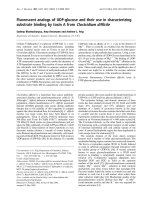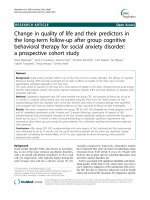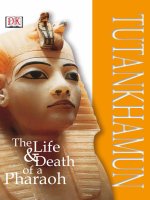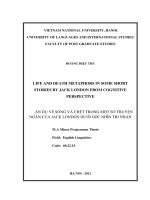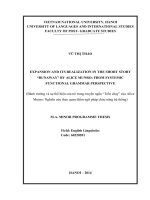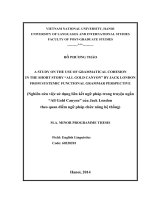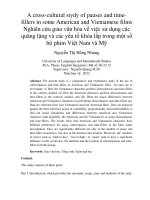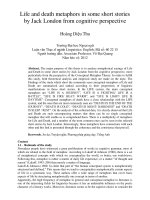Life and death metaphors in some short stories by Jack London from cognitive perspective
Bạn đang xem bản rút gọn của tài liệu. Xem và tải ngay bản đầy đủ của tài liệu tại đây (146.89 KB, 4 trang )
Life and death metaphors in some short stories
by Jack London from cognitive perspective
Hoàng Diệu Thu
Trường Đại học Ngoại ngữ
Luận văn Thạc sĩ ngành Linguistics: English; Mã số: 60 22 15
Người hướng dẫn: Associate Professor. V Đại Quang
Năm bảo vệ: 2012
Abstract. The major purpose of this thesis is to analyze metaphorical sayings of Life
and Death in some short stories by Jack London from the cognitive perspective, more
particularly from the perspective of the Conceptual Metaphor Theory. In order to fulfill
this study, both theoretical analysis and empirical study are made on the topic. The
Findings of the study which show the commonly seen conceptual metaphors of Life and
Death are summarized and ranked according to their proportions of linguistic
manifestations in those short stories. In the LIFE system, the main conceptual
metaphors are “LIFE IS A JOURNEY”, “LIFE IS A FIGHTING/ LIFE IS A
BATTLE”, “LIFE IS FIRE/ HEAT/ WARM”, and “LIFE IS LIGHT/ LIFE IS
DAYTIME”. Conceptual metaphors of death have a close relationship with the LIFE
system, and the ones that are most commonly seen are “DEATH IS THE END OF THE
JOURNEY”, “DEATH IS COLD”, “DEATH IS NIGHT/ DARKNESS” and “DEATH
IS SLEEP / REST”. On the analysis of the collected data, it is clearly observed that Life
and Death are such encompassing matters that there can be no single conceptual
metaphor that will enable us to comprehend them. There is a multiplicity of metaphors
for Life and Death, and a number of the most common ones can be seen in the selected
short stories by Jack London. Interestingly, these metaphors have connections with each
other and this link is presented through the coherence and the consistence that prevail.
Keywords. Ẩn dụ; Truyện ngắn; Phương pháp giảng dạy; Tiếng Anh
Content
1.1 . Rationale of the study
Nowadays people have witnessed a great proliferation of works in cognitive grammar, most of
which are related to the field of metaphor. According to Lakoff & Johnson (1980), there is a set
of metaphorical concepts with which we conceptualize the world, or better, our worldviews.
Following this, metaphor is rather a matter of daily life experience, or a matter “of thought and
reason” (Lakoff, 1993: 208) than merely a matter of language.
Lakoff & Johnson (1980: 6) claim that part of “the human conceptual system is metaphorically
structured and defined.” This means that we tend to conceptualize metaphorically certain aspects
of life in a systematic way. These authors offer a wide range of metaphors that cover basic
aspects of life by structuring metaphorically one concept in terms of another.
Apparently, the high frequency of metaphor in general and conceptual metaphor in literature is
one of the interesting fields for linguistics because it has an undeniable influence on the poetic
character of a literary works. Moreover, literature seems to be the superior choice to consider the
product of imagination which reflects the real life. Because of the woven of imagination and real
life, the language used on literature is not only imaginative but also realistic, which allows
people to examine metaphors in both “ordinary and extraordinary” perspectives.
There are a number of researchers and linguists take metaphors in literature as favorite topic for
their studying. As Semino & Steen, (2008: 233) metaphors in literature is considered “more
create, novel, original, striking, rich, interesting, complex, difficult, and interpretable” than
conventional metaphor. Among various metaphor concepts, Life and Death metaphors have been
taken into consideration by many linguistics. But it seems that the Life and Death metaphors are
often investigated separately. For that reason, the present paper would like to take investigation
in both metaphor concepts for the image of Life and Death.
Jack London, whose fiction clearly indicates the ways in which both his personal experiences
and his reading shaped his outlook, always showed the theme of man's attempts to survive the
forces of nature, the threat of savages, and the competition with other fortune seekers. In Jack
London’s short stories, the battle between Life and Death is presented clearly and interestingly,
without the existence of the other.
For that reason, the present paper would like to investigate the metaphor concept of Life and
Death in some short stories by Jack London from the cognitive perspective.
1.2. Aims and objectives of the study
1.2.1. Aims of the study
This paper is to find out the mapping of conceptual metaphors for Life and Death in some short
stories by Jack London. It is expected that with the finding established, an overview of LIFE and
DEATH metaphors in the obtained literature will be brought about. Also, implications for
language teaching and learning are offered.
1.2.2. Objectives of the study
The objectives of the study can be elaborated into the following research questions.
- What are the common types of metaphors for the Life and Death image in Jack London’s short
stories seen from the cognitive perspective?
- What are the markers of coherence and consistence of Life and Death metaphors based on the
framework advocated by Lakoff & Johnson?
- What are the possible implications for language teaching and learning?
1.3. Significance of the study
Metaphor is one of the most basic phenomena in human language. This kind of study has
significance not only for investigation into language in use, but also for the research of human
mind. Besides theoretical significance, this study also sheds light on second language teaching
and learning. This thesis aims to analyze metaphorical sayings of Life and Death from the
cognitive perspective, i.e. to view the sayings of Life and Death from the perspective of the
Conceptual Metaphor Theory. Both theoretical analysis and empirical study are conducted on the
topic.
1.4. Scope of the study
The present study takes its basic theoretical background from the work of Lakoff & Johnson
(1980), Lakoff & Turner (1989), and Lakoff (2006), where metaphorical expression is conceived
as the surface realization of cross-domain mapping in the 128 conceptual systems.
Due to the limited time, space and the author’s ability, the present paper just investigates the
conceptual metaphors for Life and Death expressed in some famous works by Jack London in
the light of theory raised by G. Lakoff & M. Johnson.
1.5. Structure of the study
The study consists of five chapters.
Chapter 1, Introduction, is spared for the presentation of the rationale, aims, significance,
scope, and the structure of the study.
Chapter 2, Literature review, provides the necessary information about the theoretical
background related to metaphor based on Lakoff & Johnson’s perspective.
Chapter 3, Methodology, provides information about the principles that govern the research and
the methods to be employed.
Chapter 4, Findings and Discussion, presents the findings obtained and sound discussions on
those findings.
Chapter 5, Conclusion, provides a recapitulation of the main issues and problems presented in
the study. The main content in this chapter is the specific conclusions on each of the research
question. Also, implications for teaching and suggestion for further research have been supplied.
This subsection brings about the practical value to the thesis from which readers can, to different
degrees, benefit.
References
1. Deignan, Alice (2005). Metaphor and Corpus Linguistics. Amsterdam: John Benjamins
Publishing Company, pp.2
2. Goatly, A. (2011). The language of metaphors, Routledge, London, pp. 109
3. Hurtado, (2011). A cognitive approach to life and death in the poetry of Seamus Heaney
and Robert Frost. Unpublished master's thesis. Universidad Rey Juan Carlos.
4. Kövesces, Zoltán (2002). Metaphor: A Practical Introduction. Oxford: Oxford University
Press, pp. 6
5. Kovecses, Z. (2003). "Language, Figurative Thought, and Cross-Cultural Comparison",
Metaphor and symbol, vol. 18, no. 4, pp. 311 – 312.
6. Kövecses, Z. (2003). "The scope of metaphor" in Metaphor and metonymy at the
crossroads: a cognitive perspective, ed. A. Barcelona, Mouton de Gruyter, Berlin. Pp. 82,
84.
7. Lakoff, George and Mark Johnson (1980). Metaphors We Live By. Chicago: University
of Chicago Press, pp. 4, 15.
8. Lakoff, George and Mark Turner (1989). More Than Cool Reason: A Field Guide to
Poetic Metaphor. Chicago: University of Chicago Press, pp. 50.
9. Lakoff, G. (1993) ‘The contemporary theory of metaphor’, in Ortony, A (ed.) Metaphor
and Thought, Cambridge University Press, Cambridge. (2nd ed.), pp. 208.
10. Lakoff, G. & Johnson, M. (2003), Metaphors we live by, [New ed.] edn, University of
Chicago Press, Chicago, pp. 6, 8, 14, 33, 35.
11. NGUYEN, T. (2011), An investigation into linguistic features of conceptual metaphors in
English and Vietnamese. Unpublished master's thesis. Danang University.
12. Richardt, S. (2005), Metaphor in languages for special purposes: the function of
conceptual metaphor in written expert language and expert-lay communication in the
domains of economics, medicine and computing, Peter Lang, Frankfurt am Main, pp. 48.
13. Ruiz, J. (2007). Linguistics, and cognition: Death metaphor in fairy tales. Unpublished
master's thesis. University of La Rioja.
14. Sánchez, R. (2007). Imaginative Use of the Metaphorical Concept ‘Life is a Journey’ in
Dobyns’ Body Traffic: the Creation of the Novel Imaginative Metaphor ‘the Body is a
Vehicle’. Unpublished master's thesis. University of Granada, Spain.
15. Semino, E & Steen, G.J. (2008). Metaphor in literature. In R.W. Gibbs, jr (Ed.). The
Cambridge handbook of metaphor and thought. Cambridge: Cambridge University Press,
pp. 233.
WEBSITES AS SOURCE FOR THE DATA OBTAINED IN THE THESIS
1.
2.
3.
